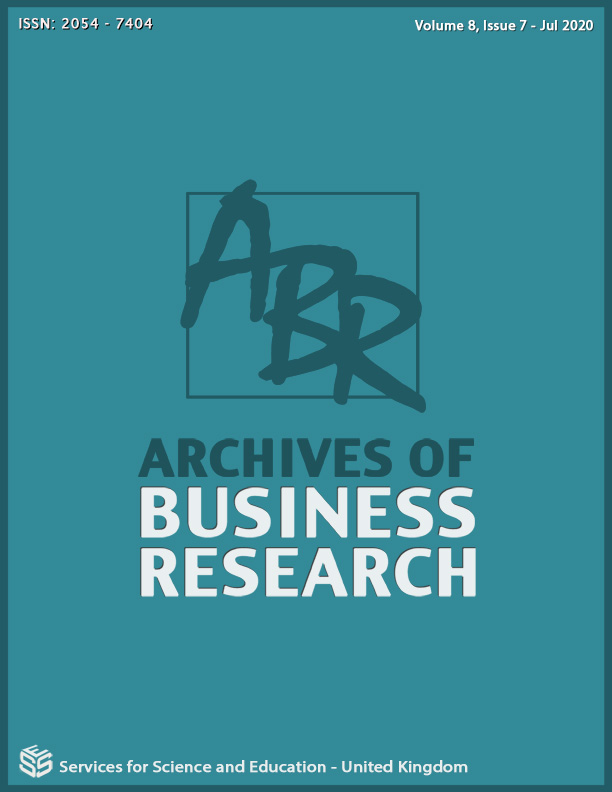The Influences of Green Attributes of Electronic Sphygmomanometer on Consumer’s Purchase Behavior
DOI:
https://doi.org/10.14738/abr.87.8608Keywords:
Green product; Blood pressure; Sphygmomanometer; Conjoint analysis.Abstract
Background: In recent years, high blood pressure has been one of the top ten causes of death in Taiwan. Operating the sphygmomanometer regularly to observe changes in blood pressure, and to track and observe one’s own basic health. This study focuses on the specification which electronic sphygmomanometer manufacturer can provide during the design for green attributes that meet customer’s preference. The subject of this study is to explore the preference of green electronic sphygmomanometer attributes Including power-saving, carbon footprint, recyclable, safety, streamline design and green accreditation from potential green computer buyers. Methods: The data was gathered through online survey over a month period from April, 2020 to May, 2020. Data is collected from convenience samples. 101 valid respondents were used for the conjoint analysis. Results: As the main purpose of this study is to find out the most importance attribute of green electronic sphygmomanometer what customer prefers, the result shows that carbon footprint turns out as the most influential attribute with the average importance of 18.63%, although it may not be considered as the majority factor in the decision-making process, it still stands out since there are six attributes in comparison. Green accreditation is the second important attribute with 17.31%, followed by recyclability and power-saving with at 16.83% and 16.15% respectively. The last two attributes, streamline design and safety, are relatively less important with 15.81% and 15.28% respectively. Conclusions: This study attempts to integrate the relevant green electronic sphygmomanometer attributes into a comprehensive research model. The conjoint analysis and the model of purchase intention for green electronic sphygmomanometer s creates an important alternative view of the antecedents.
References
[2]. Mintu, A. T., & Lozada, H. R., Green marketing education: A call for action. Marketing Education Review, 1993. 3(3): p. 17-23. https://doi.org/10.1080/10528008.1993.11488420
[3]. Lin, K. H., Shih, L. H., & Lee, S. C., Optimization of product line design for environmentally conscious technologies in notebook industry. International Journal of Environmental Science and Technology, 2010. 7(3): p. 473-484. https://doi.org/10.1007/BF03326157
[4]. Green, P. E., & Rao, V. R., Conjoint measurement for quantifying judgmental data. Journal of Marketing Research, 1971. 8(3): p. 355-363. https://journals.sagepub.com/doi/10.1177/002224377100800312
[5]. Carroll, J. D., & Green, P. E., Psychometric methods in marketing-research part 1: conjoint analysis. Journal of Marketing Research, 1995. 32(4): p. 385-391. https://doi.org/10.1177/002224379503200401
[6]. Dangelico, R. M., & Pontrandolfo, P., From green product definitions and classifications to the green option matrix. Journal of Cleaner Production, 2010. 18(16-17): p. 1608-1628. https://doi.org/10.1016/j.jclepro.2010.07.007
[7]. Chen, Y. S., The drivers of green brand equity: green brand image, green satisfaction, and green trust. Journal of Business Ethics, 2010. 93(2): p. 307-319. https://doi.org/10.1007/s10551-009-0223-9
[8]. Myers, M. G., A Short History of Automated Office Blood Pressure - 15 Years to SPRINT. The Journal of Clinical Hypertension, 2016. 18(8): p. 721-724. https://doi.org/10.1111/jch.12820
[9]. Hsieh, C. Y., & Chen, K. H., Boost DC-DC converter with fast reference tracking (FRT) and charge-recycling (CR) techniques for high-efficiency and low-cost LED driver. IEEE Journal of Solid-State Circuits, 2009. 44(9): p. 2568-2580. https://ieeexplore.ieee.org/abstract/document/5226773
[10]. Hall, C. R., Campbell, B. L., Behe, B. K., Yue, C. Y., Lopez, R. G., & Dennis, J. H., The appeal of biodegradable packaging to floral consumers. Hortscience, 2010. 45(4): p. 583-591.
[11]. Varon, E., Why green is better. CIO, 2007. 20(12): p. 32-34. https://doi.org/10.21273/HORTSCI.45.4.583
[12]. Hertwich, E. G., & Roux, C., Greenhouse gas emissions from the consumption of electric and electronic equipment by Norwegian households. Environmental Science & Technology, 2011. 45(19): p. 8190-8196. https://doi.org/10.1021/es201459c
[13]. Lu, L. T., Wernick, I. K., Hsiao, T. Y., Yu, H., Yang, Y. M., & Ma, H. W., Balancing the life cycle impacts of notebook computers: Taiwan’s experience. Resources Conservation and Recycling, 2006. 48(1): p. 13-25. https://doi.org/10.1016/j.resconrec.2005.12.010
[14]. Masuda, Y., Nakayama, M., & Wakihara, M., Fabrication of all solid-state lithium polymer secondary batteries using PEG-borate/aluminate ester as plasticizer for polymer electrolyte. Solid State Ionics, 2007. 178(13-14): p. 981-986. https://doi.org/10.1016/j.ssi.2007.04.009
[15]. Clemenz, G., Eco-Labeling and horizontal product differentiation. Environmental & Resource Economics, 2010. 45(4): p. 481-497. https://doi.org/10.1007/s10640-009-9324-2
[16]. Archer, H., Kozak, R., & Balsillie, D., The impact of forest certification labelling and advertising: An exploratory assessment of consumer purchase intent in Canada. Forestry Chronicle, 2005. 81(2): p. 229-244. https://doi.org/10.5558/tfc81229-2
[17]. Ward, D. O., Clark, C. D., Jensen, K. L., Yen, S. T., & Russell, C. S., Factors influencing willingness-to-pay for the energy star label. Energy Policy, 2011. 39(3): p. 1450-1458. https://doi.org/10.1016/j.enpol.2010.12.017
[18]. Sammer, K., & Wüstenhagen, R., The influence of eco-labelling on consumer behaviour - results of a discrete choice analysis for washing machines. Business Strategy & the Environment, 2006. 15(3): p. 185-199. https://doi.org/10.1002/bse.522
[19]. Green, P. E., & Srinivasan, V., Conjoint analysis in consumer research - issues and outlook. Journal of Consumer Research, 1978. 5(2): p. 103-123. https://doi.org/10.1086/208721
[20]. Green, P. E., & Krieger, A. M., Segmenting markets with conjoint-analysis. Journal of Marketing, 1991. 55(4): p. 20-31. https://doi.org/10.1177/002224299105500402
[21]. Rokka, J., & Uusitalo, L., Preference for green packaging in consumer product choices - Do consumers care? International Journal of Consumer Studies, 2008. 32(5): p. 516-525. https://doi.org/10.1111/j.1470-6431.2008.00710.x
[22]. Min, S. H., Kim, H. Y., Kwon, Y. J., & Sohn, S. Y., Conjoint analysis for improving the e-book reader in the Korean market. Expert Systems with Applications, 2011. 38(10): p. 12923-12929. https://doi.org/10.1016/j.eswa.2011.04.087






